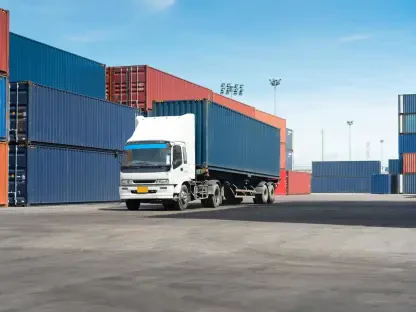A staggering 73% reduction in crash rates has been achieved by fleets implementing comprehensive AI safety solutions, underscoring the transformative potential of technology in modern transportation and reshaping how industries approach driver behavior. This remarkable statistic highlights how artificial intelligence is becoming a cornerstone in fleet safety management, focusing on risk mitigation and operational efficiency. The focus here is on exploring AI’s profound impact through hard data, real-world applications, expert insights, and its promising future in redefining safety standards across diverse sectors.
The Rise of AI in Fleet Safety: Data-Driven Insights
Growth and Adoption Trends
The adoption of AI in fleet safety has surged, with extensive data revealing its undeniable influence on operational outcomes. Analysis from a vast dataset encompassing over 2,600 fleets and 20 trillion annual data points showcases the scale of this shift, covering billions of miles driven in recent years. This data points to a clear trend: AI is no longer a niche tool but a fundamental component for enhancing safety protocols across industries.
A key finding is the 73% crash rate reduction for fleets using a fully integrated AI safety solution, nearly double the improvement observed in systems with limited integration. This disparity emphasizes the value of comprehensive platforms that provide real-time insights and automation. The universal move toward AI-driven safety tools reflects a broader industry consensus on the need for actionable data to prevent incidents before they occur.
Industries ranging from logistics to public transportation are embracing this technology, recognizing its capacity to deliver immediate and long-term benefits. The trend is not confined to specific sectors but represents a cross-industry push for innovation. Automation and visibility are now seen as essential drivers of safety improvements, setting a new benchmark for fleet management practices.
Real-World Impact and Applications
The practical outcomes of AI in fleet safety are striking, with measurable reductions in risky behaviors within short timeframes. For fleets with over 175 vehicles, harsh driving events—such as abrupt braking or rapid acceleration—dropped by 49% within six months of adopting AI platforms. Even more impressive is the 84% decline in mobile phone use during the same period, addressing a critical distraction factor.
Long-term data further illustrates the sustainability of these improvements, with harsh driving incidents decreasing by 69% and mobile phone use plummeting by 96% after an extended duration. These figures suggest that AI, when paired with consistent driver coaching, fosters enduring behavioral changes. The technology acts as a catalyst for building safer habits among drivers, ensuring a lasting impact.
A standout feature in achieving these results is the use of dual-facing AI dash cams, which monitor both the driver and the road ahead. These devices have proven to deliver crash rate reductions more than twice as high as single, front-facing cameras. This enhanced visibility into driver actions and external conditions underscores the power of integrated technology in preventing accidents and improving overall safety.
Expert Perspectives on AI’s Role in Fleet Safety
Expert analysis reinforces the transformative role of AI in mitigating risks within fleet operations. Insights drawn from comprehensive studies highlight how real-time feedback and in-cab alerts create a proactive approach to safety. This technology empowers managers to address issues as they arise, significantly reducing the likelihood of incidents.
A crucial aspect emphasized by industry professionals is AI’s ability to cultivate a culture of accountability among drivers. Through immediate coaching and data-driven insights, fleets can encourage safer practices without relying solely on punitive measures. This shift toward constructive feedback is seen as a game-changer in fostering trust and compliance within teams.
While the benefits are clear, challenges such as integration complexities and initial adoption barriers remain. However, the evidence of compounding advantages—such as sustained reductions in crashes and improved regulatory adherence—outweighs these hurdles. Experts agree that with strategic implementation, AI can deliver measurable outcomes that justify the investment, paving the way for broader acceptance across fleets of all sizes.
The Future of AI in Fleet Safety Management
Looking ahead, AI’s potential in fleet safety is poised to grow with advancements in predictive analytics and deeper integration with complementary technologies. Innovations could enable systems to anticipate risks before they manifest, further slashing crash rates through preemptive measures. The evolution of automation also promises to streamline operations, reducing human error in high-stakes environments.
Significant benefits are on the horizon, including enhanced operational efficiencies and even greater safety improvements. Yet, concerns around data privacy and implementation costs must be addressed to ensure widespread adoption. Balancing these challenges with the undeniable advantages will be critical for scaling AI solutions across diverse fleet operations.
The broader implications of this trend are profound, as early adopters of AI are already setting new safety benchmarks. Their success is reshaping expectations, pushing industries to prioritize technology-driven strategies for safer roads. This movement is likely to influence regulations and standards globally, creating a ripple effect that benefits drivers and communities alike.
Key Takeaways and Call to Action
AI stands as a powerful force in fleet safety, delivering rapid reductions in crash rates, harsh driving events, and distractions like mobile phone use, alongside a notable 43% improvement in Unsafe Driving scores. These metrics reflect the technology’s immediate impact on compliance and risk reduction. The data paints a clear picture of AI as an essential tool for modern fleet management.
Far from being a temporary fix, AI represents a proactive, long-term strategy that transforms safety from a reactive concern into a structured priority. Its ability to adapt and improve over time ensures that fleets remain ahead of emerging risks. This approach is redefining how safety is perceived and implemented in the industry.
Fleet managers reflected on the compelling evidence and recognized the need to adopt AI-driven solutions to elevate both safety and performance. The journey toward safer roads demands action, and embracing innovative tools becomes the logical next step. This commitment to technology promises not only to protect drivers but also to set a new standard for operational excellence across industries.









